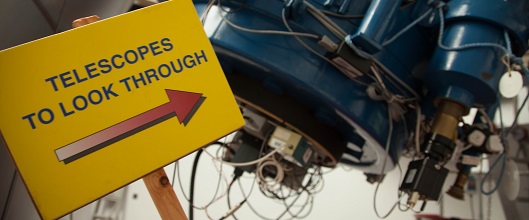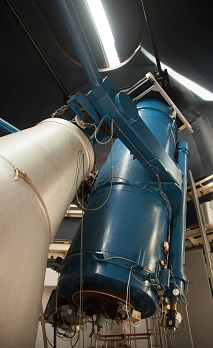A journey through the Universe

Astronomers in St Andrews are inviting members of the public to a journey from the rocky asteroids and gaseous planets of our own solar system over the dusty environment of nearby young stars to distant galaxies.
The traditional open night at the University Observatory is an opportunity to see the stars and at the same time celebrate the astronomical research being done at the School of Physics and Astronomy by the resident astronomers.
Members of the public visiting the open night will also be able to see a wall-size mural in the entranceway of the old Observatory building depicting research at the Centre for Research into Ecological and Environmental Modelling (CREEM). The mural depicts animals that have been the subject of CREEM projects, as well as some of the mathematical equations that CREEM members have used in their work.
 The highlight of the Observatory open night is the James Gregory Telescope (pictured), with its 0.94 meter aperture the largest telescope of its kind in the world and the largest telescope in Scotland. The James Gregory Telescope is a unique combination of old and new technology, conceived and constructed in St Andrews in the 1950s, inaugurated in 1962, and now computer controlled and operated with a digital camera.
The highlight of the Observatory open night is the James Gregory Telescope (pictured), with its 0.94 meter aperture the largest telescope of its kind in the world and the largest telescope in Scotland. The James Gregory Telescope is a unique combination of old and new technology, conceived and constructed in St Andrews in the 1950s, inaugurated in 1962, and now computer controlled and operated with a digital camera.
In 2016 images from the James Gregory Telescope have contributed to a number of peer-reviewed publications (see links at the bottom of this article). In the last year, it has been used to discover extrasolar planets, to derive the shapes of asteroids in our solar system, and to analyse the two-year long eclipse of the young star RW Auriga.
RW Aur is a star like the Sun, but in contrast to the Sun, it is in its infancy. While the Sun has an age of 4.5 billion years, RW Aur is only 1 million years old and is still surrounded by a ring of gas and dust, the remnants of the cloud from which the star originally formed.
These ring-shaped nebula are thought to be the birthplaces of planets. Although RW Aurigae has been observed for more than a century, it has never shown any deep long-lasting eclipse. After going through a shorter obscuration in the winter of 2010 to 2011, it again vanished in the summer of 2014, a disappearing act that ended just a few weeks ago in August 2016.
During these eclipses, RW Aur must have been obscured by something dense, dark and as big as our solar system, blocking the light of the star. At first it was speculated that what is eclipsing RW Aurigae is a part of the tidal arm far away from the star itself.
However the St Andrews team have concluded that the material blocking the light is moving towards us and contains dust heated to a temperature of around 1000 degrees. Their theory is that RW Aurigae is eclipsed by a giant screen of dust and gas that is emanating from the disk close to the star at a distance comparable to the separation between Earth and the Sun, an idea first suggested in 2015.
Images from RW Aurigae will be one of the highlights of this year’s open evening.
Observatory director Dr Aleks Scholz said: “During the open night, astronomers will be at the observatory to talk about all space-related topics, to show the telescopes and, weather permitting, the night sky.
“If the sky is clear, we will follow the transit of an exoplanet with the James Gregory Telescope. With smaller telescopes we will observe nebula, galaxies, stars, and the planet Uranus. In addition, there will be a series of short talks and games for children.”
Notes to news editors
Open Night at the Observatory is on Saturday 26 November from 6pm to 9pm. Admission is free.
Pictures courtesy of © Jan Bölsche.
Links to peer-reviewed publications:
WASP-92b, WASP-93b and WASP-118b: three new transiting close-in giant planets
New and updated convex shape models of asteroids based on optical data from a large collaboration network
The disappearing act: a dusty wind eclipsing RW Aur
Issued by the University of St Andrews Communications Office, contactable on 01334 462530 or [email protected].
Category Community